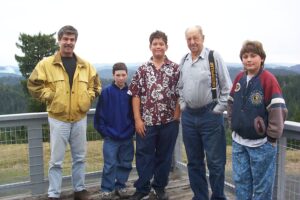
In was almost 20 years ago that students of Ryan Olson Day’s Options Class at the Mendocino Middle School created an oral history project with the help of Steve Jordan and a grant obtained by Deena Zarlin.
They made audio recordings of their interviews with 12 “Old Timers,” who told these children what it was like in the first part of the 20th century.
Kept all this time in digital form in the Kelley House Museum vault, we decided this year that these stories should be shared. Published now for the first time, here is the seventh excerpted conversation, this time with Emery Escola from November 15, 2000.
They are at his 40-acre Escola Ridge Ranch, 6 miles east of Mendocino on the Comptche Road. He is talking with students Jonathan Matlin and Kahlil Robinson. Matt Stephens is their technical recorder and Steve Jordan is there assisting them while Jonathan and Kahlil start out asking Emery about how and when his family came to Mendocino. Emery explains, “My grandfather Escola came out here in the late 1870s from Finland. And being a ship builder and a ship carpenter, he went to work for the Peterson Shipyard in Little River when he arrived here. A little later he established what was known as the Escola Ranch on the end of the ridge here in the early 1880s. My grandfather on the other side, my mother’s side of the family [Nannie Flood was his mother], came from the state of Maine and landed at Cuffey’s Cove north of Greenwood/Elk in the late 1870’s. And he, being a woodsman, went to work for L. E. White Lumber Company in Salmon Creek.”
Their original name was spelled ESKOLA, with a “k” but that was changed to a “c” when they arrived in the United States to disassociate themselves from the unfavorable Russian connotation of the other spelling.
When he was growing up, Emery and the people of Mendocino were very self-sufficient, especially during the Depression of the 1930s. “Most of the people raised their own gardens, had a cow and a pig, chickens, everything, ya’ know. In the city you couldn’t do that. So the Mendocino people were much better off in the Depression than the municipal people were.”
When he wasn’t in school during the three-month winter vacation, he and his brother would trap along Big River. “We’d catch furs and sell them to Montgomery Wards and Sears Roebuck, send them in the postal. Ace Bishop [the postmaster] never really liked them – stink like heck! But he had to take them. Coons and minks and otter didn’t get much money. A coon would make you a dollar and a half, maybe two, but at the end of the month you might have six, seven dollars.”
After serving four years in the Army during World War II, Emery spent the rest of his working life as a forest ranger, fighting forest fires for 30 years. The children were very curious about how this was done. He explained, “In forest fire fighting there’s two ways the fire’s stopped. First off, in a structure fire you remove the temperature from the building, to save the building. In a forest fire, you remove the fuel from the fire. In other words, the building is the fuel and you can’t remove the building, so you have to remove the temperature. In forestry, the forest is the fuel and you can’t remove the temperature from the atmosphere, so you remove the fuel from the fire by making a trail between the fire and the fuel. That’s the two differences.”
He goes on to explain how the forestry industry worked during those days, and about building his house from his own trees milled on the property to withstand 100-mile per hour winds because of its location on the high ridge. He gives them the story behind the “spring box” on the Comptche Road, and who owns all the communication towers up where he is. “It isn’t the highest point, but I can see parts of five counties from here.”
Toward the end of these interviews, the students always ask their subjects what their hope is for Mendocino’s future. Emery says he didn’t think it was going to change too much because of the restrictions in place to limit any major development. “But I’m not too concerned about it. I mean they’ve survived for 120 years they can survive some more.”
If you would like to hear these recorded voices or read this 21-page transcript in full, just give us a call at (707) 937-5791 and we’ll set you up for a visit at our research office at 45007 Albion Street in Mendocino. Our office and Museum hours are Fridays through Mondays, 11 a.m. to 3 p.m., or email us at curator@kelleyhousemuseum.org